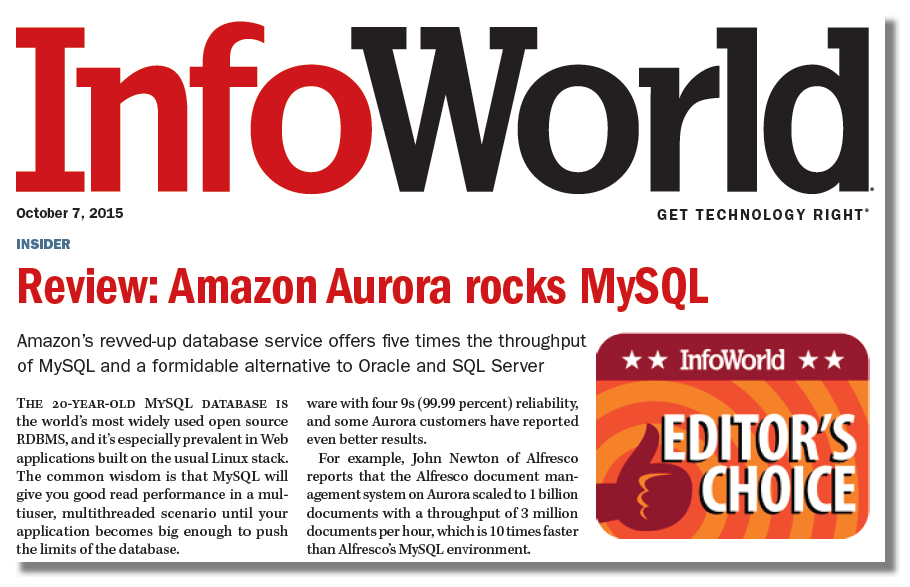Amazon Aurora is a MySQL-compatible relational database engine that combines the speed and availability of high-end commercial databases with the simplicity and cost-effectiveness of open source databases. Amazon Aurora provides up to five times better performance than MySQL with the security, availability, and reliability of a commercial database at one tenth the cost.
You can now launch Amazon Aurora database instances with either MySQL or PostgreSQL compatibility. PostgreSQL compatibility is now available in preview. Sign up for the preview.

Amazon Aurora is a great option for any enterprise application that can use a relational database. Compared to commercial databases, Amazon Aurora can help cut down your database costs by 90% or more while improving reliability and availability of the database. Amazon Aurora being a fully managed service helps you save time by automating time consuming tasks such as provisioning, patching, backup, recovery, failure detection, and repair.

Expedia, one of the largest travel companies in the world, uses Amazon Aurora for their Travel Data Application that inserts 300 millions rows of data per day, at a peak 70,000 rows per second with 17 millisecond average response time for read and 30 millisecond average response time for write.
SaaS applications often use architectures that are multi-tenant, which requires a great deal of flexibility in instance and storage scaling along with high performance and reliability. Amazon Aurora provides all of these features in a managed database offering, helping SaaS companies focus on building high quality applications without worrying about the underlying database that powers the application.
"Amazon Aurora was able to satisfy all of our scale requirements with no degradation in performance. With Alfresco on Amazon Aurora we scaled to one billion documents with a throughput of three million per hour, which is ten times faster than our MySQL environment. It just works!" - John Newton, Founder and CTO of Alfresco
Web and mobile games are built to operate at very large scale need a database with high throughput, massive storage scalability, and high availability. Amazon Aurora fulfills the needs of such highly demanding applications with enough room for future growth. Since Amazon Aurora does not have any licensing constraints, it perfectly fits the variable usage pattern of these applications.
"We store billions of rows per Amazon Aurora instance and can perform over a hundred thousand JOINs across our messages and recipients tables per second. The ability to dedup messages as they are loaded has drastically simplified our analytics. Amazon Aurora has proven to be a much better alternative to flat files or NoSQL for our very large dataset.” - Paul McReynolds, CTO, Conspire.
Amazon Aurora can provide a significant performance increase to your application while improving reliability and availability, and reducing cost at the same time. Internal testing using SysBench on r3.8xlarge instances show that Amazon Aurora delivers over 500,000 reads and 100,000 writes per second with a high level of consistency, irrespective of the size of the database and object count. You can easily run benchmark tests against an Amazon Aurora instance to compare it to the performance of your existing database or to evaluate peformance needs for a new application you are building. Detailed instructions on how to perform benchmarking are provided in the Amazon Aurora Performance Benchmarking Guide.
InfoWorld performed extensive benchmarking tests on Amazon Aurora concluding that "Amazon's revved-up database service offers five times the throughput of MySQL and a formidable alternative to Oracle and SQL Server" and giving Amazon Aurora their "Editor's Choice" award. Download the Full InfoWorld Review >>
If you are currently using Amazon RDS for MySQL or Amazon RDS for PostgreSQL, migrating to Aurora will be as simple as creating a snapshot and launching an Aurora instance from that snapshot. You can follow the simple, step by step instructions in the user guide to perform a migration from Amazon RDS for MySQL or Amazon RDS for PostgreSQL. Since Amazon Aurora is fully MySQL and PostgreSQL compatible, your applications can simply be reconnected to the new Amazon Aurora instance without any changes. Migrating to Amazon Aurora from
MySQL databases running on Amazon EC2 or on-premises also can be easily done. You can create a snapshot backup of your existing database, upload it to Amazon S3, and use it to directly create an Amazon Aurora cluster. You can also import data stored in an Amazon S3 bucket into a table in an Amazon Aurora database.Using standard MySQL import and export tools or mysql binlog replication are also supported. Migrating to Amazon Aurora from PostgeSQL databases running on Amazon EC2 or on-premises can be done using AWS Database Migration Service.
The AWS Schema Conversion Tool simplifies migration from Oracle and Microsoft SQL Server to Amazon Aurora by automatically converting the source database schema and a majority of the custom code - including views, stored procedures, and functions - to a format compatible with Amazon Aurora. Any code that cannot be automatically converted is clearly marked so that it can be manually converted. Learn more and download the AWS Schema Conversion Tool >>
Migrating data from Oracle and Microsoft SQL Server databases to Amazon Aurora can be easily done using AWS Database Migration Service. You can begin a data migration with just a few clicks, the source database remains fully operational during the migration, minimizing downtime to applications using that database. Learn more about AWS Database Migration Service >>
Thomas Publishing is a 100 year old company that began publishing the Thomas Register of American Manufacturers in 1898. Thomas Publishing migrated their production database from Oracle to Amazon Aurora using the AWS Database Migration Service and Schema Conversion Tool. The entire migration process was completed in less than 4 weeks.
Earth Networks operates the world’s largest and most comprehensive weather observation, lightning detection, and climate (GHG) networks. “We were very impressed with how easy it was to move from our current SQL Server databases to Amazon Aurora; all with only a few changes." - Eddie Dingels, Lead Architect at Earth Networks
It's easy to get started. Follow our Getting Started Guide to create your first Amazon Aurora instance with just a few clicks.
Want to know more?
Drop our AWS experts a line.
Drop our AWS experts a line
Drop our AWS experts a line
Drop our AWS experts a line
Drop our AWS experts a line
Drop our AWS experts a line
Drop our AWS experts a line
Drop our AWS experts a line
Drop our AWS experts a line
Drop our AWS experts a line
Drop our AWS experts a line
Drop our AWS experts a line
























